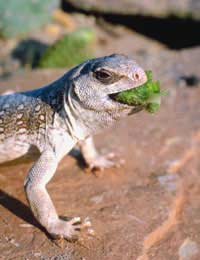What to Feed Your Reptile

The reptile world is diverse and varied, much like the eating habits of reptiles themselves. You will need to read up on the particulars of your reptile’s diet but here are some general rules of thumb to follow:
Feeding Time
Herbivores tend to need frequent, large amounts of food while carnivores tend towards smaller, less frequent feedings as the carnivore diet is protein based and so more time is needed to breakdown, process and digest. Many reptiles also benefit from fasts and breaks in their feeding schedule. So read up on the needs of your pet and feed accordingly.Remember that any reptile that lives in an aquatic or semi-aquatic environment should have any leftover food removed after about 5 to 10 minutes, much like fish; otherwise the rotting food will pollute the water. Messy eaters should have a separate feeding area to keep their water from being soiled by food bits. Pre-killed frozen foods should also be completely thawed before given to your pet and preferably at least room temperature.
The Excitement of Live Foods
Live foods provide stimulation and change for reptiles, plus encourage your pet to keep up its natural foraging behaviour. Wriggling insects, squirming worms and rodents that run and burrow can be the highlight of a reptile’s day. But be wary as live foods sometimes fight back and can inflict damage on your pet.For herbivores, live foods are a treat as well. Live branches and foliage give them something to explore as well as to feed on, you can mist branches daily to keep them vital for longer. Remember; never give your pet live food from an unknown source, like insects caught in your backyard. You don’t know where it’s been and what kind of pesticides or chemicals it’s been exposed to. Amphibians in particular are sensitive to pesticides but all reptiles can become seriously ill when exposed to chemicals and toxins.
Water, Please
Again, to determine the amount of water a reptile needs requires some research into their natural environment. You can tell that your reptile is not receiving enough moisture if its eyes are sunken or its skin is dry and wrinkled. When you take the skin of a hydrated reptile between your fingers, it will fall back into place quickly, where a dehydrated pet’s skin will stay pinched and gradually fall back. A desert snake will not need the same amount of water as a lizard from a rainforest. A water bottle with a ball works well with most reptiles, though some like a container of water instead or a water bath to soak in. Tropical reptiles and those from moist climates should have their cages misted frequently, daily if possible.Supplements
It can be difficult to fulfill the exact dietary requirements of a reptile in the wild, most species benefit from a supplement with their diet. For example, calcium and phosphorus are essential for the health of the reptile skeletal structure and shell, if it has one. Gastric acid helps to digest food and vitamin B-12 helps boost energy levels and appetite in reptiles. When purchasing supplements, make sure you check the expiration date to make sure they are still effective, however.What to Watch Out For
Bacteria in meat can cause health problems for carnivores, particularly in the bodies of rodents. Pre-killed food that has been stored in a freezer for 30 days is the safest, healthiest way to get rid of any bacteria. Mealworms are a commonly food for carnivores but are low in calcium, something vital for the reptile health, and should be boosted with a calcium supplement for your pet.With herbivores, lettuce should be avoided since it has little nutritional content, veggies that are high in fibre and dark, leafy greens are best for herbivores. Spinach, however, is also a no-no as it stops reptiles from absorbing calcium properly.


Re: Is Your Child Ready to Walk the Dog?
I am a 12 year old that love dog and I love walking your dog so pls let me do so
Re: Is Your Child Ready to Walk the Dog?
Hi I am eva I am 11 and my freind is 10 me and my freind love dogs and love walking and have loads of experience with…
Re: Is Your Child Ready to Walk the Dog?
My name is halima and I am 10 I want to walk dogs because they are my favourite animal and I would enjoy to walk them
Re: Is Your Child Ready to Walk the Dog?
Hi,my name is Emma I am 13 years old I have 2 dogs of my own and I train one of them I love all dogs and have walked…
Re: Is Your Child Ready to Walk the Dog?
Hi I'm Hamish I'm 10 years old I want to do dog walking to save up to spend time with my family in Australia I like dogs…
Re: Is Your Child Ready to Walk the Dog?
Hi,my name is Mario and I am looking for a job to do with dog walking,I’m looking to save up money for the summer
Re: Is Your Child Ready to Walk the Dog?
Hi,my name is Mario,I’m 11 years old and I’m looking for a job to do with dog walking,I need the job because I want to…
Re: Is Your Child Ready to Walk the Dog?
Hi my nam is Harley I want to walk dogs with my friend Chris we are both 10 an experienced dog walking
Re: Is Your Child Ready to Walk the Dog?
Hello, I am 11 years old and I would love to be a Dog Walker! I have walked dogs all my life and been around animals all…
Re: Is Your Child Ready to Walk the Dog?
I love dogs but have to cats i want to walk dogs at age 13 now for a business and prices 5$ for 15 min 10$ for 30 15$…